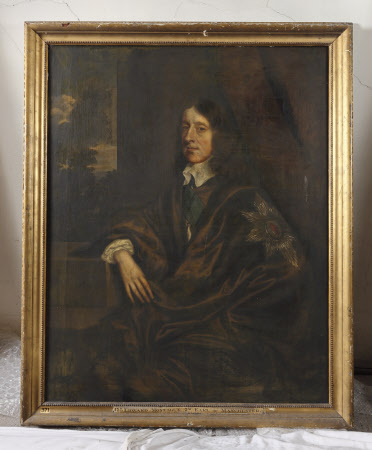William Cecil, 2nd Earl of Salisbury (1591 – 1668)
after Sir Peter Lely (Soest 1618 – London 1680)
Category
Art / Oil paintings
Date
Unknown
Materials
Oil on canvas
Measurements
1180 x 935 mm
Place of origin
England
Order this imageCollection
Hardwick Hall, Derbyshire
NT 1129224
Caption
William Cecil, 2nd Earl of Salisbury was the only son of Robert Cecil, 1st Earl of Salisbury (1563-1612) and Elizabeth Brook, (1563-1597). He married, in 1608, Catherine Howard (d.1672/3), the only daughter of Thomas Howard, Earl of Suffolk. He was made a Knight of the Garter in 1624, and sat in Cromwell’s House of Lords in 1645-48. His son Charles Cecil, Viscount Cranborne (1619-1660) predeceased him and his grandson by Viscount Cranborne, James Cecil (1646-1683) became 3rd Earl of Salisbury. During the 1660s Samuel Pepys visited Hatfield, the Salisbury seat. He much admired the house and the chapel, and above all the gardens, ‘such as I never saw in all my life; nor so good flowers, nor so good gooseberries, as big as nutmegs’. The owner of the gooseberries impressed him less. ‘Got to Hatfield’, Pepys related, ‘and saw my simple Lord Salisbury there in his gallery.’
Summary
Oil painting on canvas, William Cecil, 2nd Earl of Salisbury (1591 – 1668), after Sir Peter Lely (Soest 1618 – London 1680). A three-quarter-length portrait, seated to left, head facing, wearing brown cloak with embroidered star on left shoulder, white lawn collar and ribbon of the Garter. Along the bottom of the picture is inscribed ... QUI MAL ..., all that can be discerned of the garter motto.
Provenance
In Swift 1811 inventory and thence by descent until, following the death of Edward William Spencer Cavendish, 10th Duke of Devonshire (1895 - 1950), Hardwick Hall and its contents were accepted by HM Treasury in part payment of death duties and transferred to the National Trust, in 1959
Credit line
Hardwick Hall, The Devonshire Collection (National Trust)
Marks and inscriptions
at bottom QUI MAL (all that can be discerned of the Garter motto)
Makers and roles
after Sir Peter Lely (Soest 1618 – London 1680), artist

